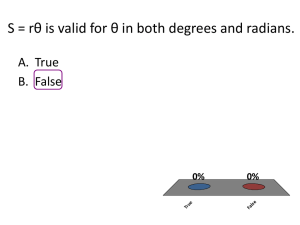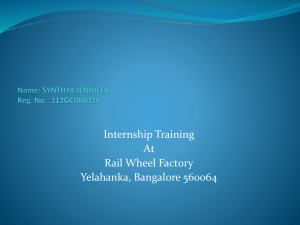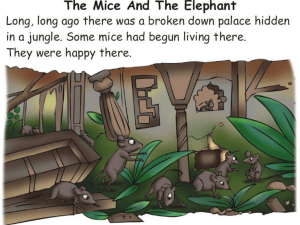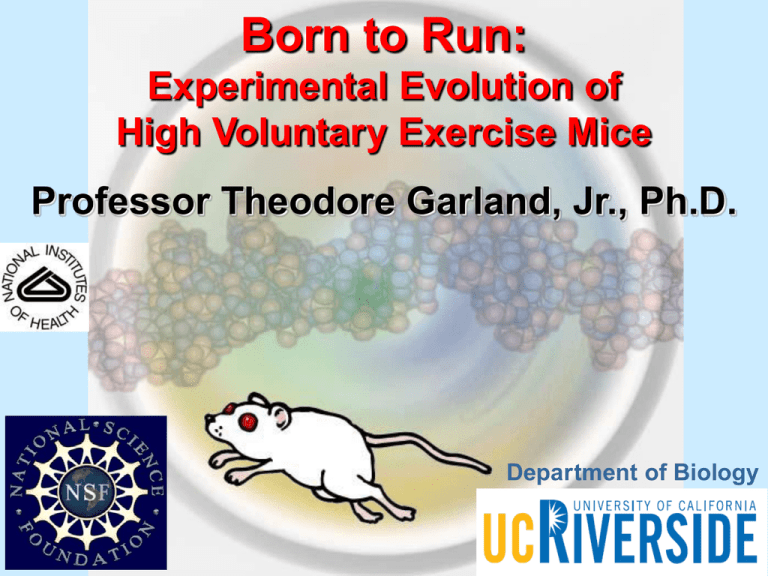
Born to Run:
Experimental Evolution of
High Voluntary Exercise Mice
Professor Theodore Garland, Jr., Ph.D.
Department of Biology
1
Collaborators in Our Lab
or at U.C., Riverside:
Collaborators Elsewhere
(partial list):
Wendy Acosta
Doug Altshuler
Anne M. Bronikowski
Vincent Careau
Patrick A. Carter
Mark A. Chappell
Gerald C. Claghorn
Mark A. Coleman
Elizabeth Dlugosz
Isabelle Girard
Fernando R. Gomes
Robert M. Hannon
Brooke K. Keeney
Scott A. Kelly
Erik M. Kolb
Terry Belke
Abel Bult-Ito
Hannah Carey
Greg Cartee
Lynn Copes
Serge Daan
Brigitte Demes
Gary Diffee
Cynthia Downs
Joey C. Eisenmann
Patricia A. Freeman
Fred H. (Rusty) Gage
Stephen C. Gammie
Helga Guderley
Russ Hepple
Peter Hurd
Aaron M. Janowsky
Denis Joanisse
Pawel Koteja
Guo Li
Chris Lytle
Jessica L. Malisch
Morris & Gina Maduro
Thomas H. Meek
Kevin Middleton
Tricia Radojcic
Enrico L. Rezende
Justin S. Rhodes
Derek Roff
Heidi Schutz
John Shyy
John G. Swallow
Shizhong Xu
Many Undergrads
Isabella Jonas
Grant McClelland
Kevin M. Middleton
Gordon S. Mitchell
Andy Obenaus
Mark Olfert
Steve F. Perry
Daniel Pomp
Thomas A. Prolla
Gary Sieck
Sharon Swartz
Doug Syme
Nicole Templeman
Lobke M. Vaanholt
Gertjan van Dijk
Henriette van Praag
G. Henk Visser
Ben B. Yaspelkis III
This selection experiment began in 1993,
> 100 publications.
2
Background
&
Introduction
3
Evolutionary Physiology
How do populations change
over time?
How can we use "model
organisms" to understand
how evolution and genetics
work?
How important is natural
selection in shaping
biological diversity?
How do organisms work?
How can we use "model
organisms" to understand
how organisms work?
Where is the line between
"normal" individual
variation and pathology?
How do we promote health
and cure disease?
How does the way organisms work
influence the way they evolve?
Copyright by Theodore Garland, Jr. May 2007
4
We are studying:
Animal Locomotion
from the perspective of
Evolutionary Physiology
5
An Observation about Behavior:
Animals exhibit tremendous diversity in
locomotor behavior (e.g., home range size).
6
An Observation about Behavior:
Animals are diverse in locomotor behavior
(e.g., home range size).
Evolutionary causes:
Why has this diversity evolved?
Natural selection: what is the benefit?
Physiological causes:
How do animals work?
Body structure and physiology: what is the limit?
"Motivation" vs. performance ability?
7
Diversity in Locomotor Behavior
log10 Home Range Area (km2)
49 Species of Mammals
Large animals
tend to have large
home ranges.
3
2
But, even for
different animals that
are the same size,
home ranges are
very diverse and can
be 100-times
different.
1
0
-1
-2
0
1
2
log10 Body Mass (kg)
3
Note the logarithmic axes.
8
Diversity in Locomotor Behavior
log10 Home Range Area (km2)
49 Species of Mammals
3
Carnivora
2
1
0
ungulates
-1
-2
0
1
2
log10 Body Mass (kg)
3
Carnivores
tend to
have larger home
ranges than herbivores.
9
An Observation about Behavior:
Animals are diverse in locomotor behavior
(e.g., home range size).
Evolutionary causes:
Why has this diversity evolved?
Natural selection: what is the benefit?
Physiological causes:
How do animals work?
Body structure and physiology: what is the limit?
"Motivation" vs. performance ability?
10
Diversity in Locomotor Behavior
log10 Home Range Area (km2)
49 Species of Mammals
3
Carnivora
2
Eat
Herbivores
1
0
ungulates
Might the kind of diet be a
reason for the diversity?
-1
-2
0
1
2
Eat Plants
3
log10 Body Mass (kg)
Garland, T., Jr., A. W. Dickerman, C. M. Janis, and J. A. Jones. 1993. Phylogenetic analysis of covariance by computer simulation. Systematic Biology 42:265-292.
11
Diversity in Locomotor Behavior
log10 Home Range Area (km2)
49 Species of Mammals
3
Carnivora
2
Eat
Herbivores
1
0
ungulates
Possibly just a direct
environmental effect?
-1
-2
0
1
2
Eat Plants
3
log10 Body Mass (kg)
12
An Observation about Behavior:
Animals are diverse in locomotor behavior
(e.g., home range size).
Evolutionary causes:
Why has this diversity evolved?
Natural selection: what is the benefit?
Physiological causes:
How do animals work?
Body structure and physiology: what is the limit?
"Motivation" vs. performance ability?
13
We can attempt to answer these
questions with experimentation.
Lions, and tigers, and bears
(oh my!) are great, but not the most
convenient organisms to study …
15
"…research in which
populations are studied
across multiple generations
under defined and
reproducible conditions,
whether in the laboratory
or in nature."
16
Charles Darwin did not
recognize this as a way to
study evolution because
he thought the process
was too slow.
17
Humans can also show
diversity in locomotor behavior.
Locomotion & Activity Levels
● Individual differences in voluntary activity
levels are large in both human beings and
other animals (both in the lab and in the wild).
19
An Observation about Behavior:
Animals are diverse in locomotor behavior
(e.g., home range size).
Evolutionary causes:
Why has this diversity evolved?
Natural selection: what is the benefit?
Physiological causes:
How do animals work?
Body structure and physiology: what is the limit?
"Motivation" vs. performance ability?
20
Locomotion & Activity Levels
● Individual differences in voluntary activity
levels are large in both human beings and
other animals (both in the lab and in the wild).
● Physiology: what are the causes of these
individual differences?
● may be related to variation in both motivation and
ability to perform physical activity (brain & brawn);
● may also be part of the homeostatic mechanisms
for energy balance and body composition.
21
Locomotion & Activity Levels
● Both motivation & ability must be affected by
1) multiple alleles (genes),
2) numerous environmental factors,
3) interactions of genes and environment.
You can lead a
horse to water,
but you can't
make him drink!
22
Genetic Factors in Locomotion
and Activity Levels
Locomotion & Activity Levels
● Both motivation & ability must be affected by
1) alleles (genes) segregating at multiple loci,
2) numerous environmental factors,
3) interactions of genes and environment.
● Except in certain pathological conditions,
we should not expect to find "the gene for
activity," but we can hope to find genes
(polygenes) that account for an important
fraction of the variation in activity levels.
24
Locomotion & Activity Levels
● Both motivation & ability must be affected by
1) alleles (genes) segregating at multiple loci,
2) numerous environmental factors,
3) interactions of genes and environment.
● Except in certain pathological conditions,
we should not expect to find "the gene for
activity," but we can hope to find genes
(polygenes) that account for an important
fraction of the variation in activity levels.
● Understanding how such genes work could
lead to therapeutic strategies for low-activity
individuals.
25
Experimental Evolution
• Evolution:
– Can we cause activity levels to change across
generations by selective breeding?
– Are genes important in determining activity levels?
• Physiology:
– How is body structure affected? Bones, muscles,
circulatory system?
– What is the role of motivation? Brain structure?
– What is the role of metabolism?
Methods
27
Why Select on Wheel-Running?
1. potentially physiologically taxing
- did you ever have a pet hamster?
2. individual differences are highly
repeatable (consistent) from day-to-day
3. genetically inherited to some extent
4. easy to automate measurement
5. an important regulator of
body mass and composition
6. analogous to human voluntary activity?
(e.g., Eikelboom, 1999)
http://school.discovery.com/clipart/clip/ani-mouse.html
28
Experimental Design
Starting (Base) Population:
112 male & 112 female outbred mice
Design:
8 lines: 4 Selected for High Running
(HR lines), 4 non-selected Control
10 mating pairs in each (litter size ~10)
Within-family selection
Selection Criterion:
Wheel revolutions on days 5 + 6
This is a completely "voluntary" behavior.
29
Important point!
● We did not select for low voluntary running
because it might not be the same trait as high
wheel running.
● For example, selection for low running might simply
increase fear of entering the wheels.
● For humans, active behaviors may not be
opposites of sedentary behaviors.
● Jogging is not the opposite of playing a video game.
● Also, selection for low performance might be
accomplished by increasing frequency of
“harmful” alleles (deleterious recessives), thus
leading to sickly mice from a variety of causes.
30
Wheels are Attached to Standard Housing Cages
31
200 total
wheels,
100 in each
of two rooms
Food and
water are
always
available.
32
Results
33
Revolutions/Day on days 5 + 6
17000
Wheel Circumference = 1.12 m
15000
Selected
13000
11000
Our lab
moved from
U. Wisconsin
to U. Calif.
9000
Selected run almost 3X more than control
7000
Control
5000
3000
1000
0
0
14FRUN56.DSF
55
10
10
15
15
20
20
25
25
30
30
Generation
35
35
40
40
45
45
50
50
34
Revolutions/Day on days 5 + 6
17000
Wheel Circumference = 1.12 m
15000
Males always tend to run less than females,
but the fold difference between selected and
control lines is the same as in females.
13000
Selected
11000
9000
7000
Control
5000
3000
1000
0
0
14MRUN56.DSF
5
5
10
10
15
15
20
20
25
25
30
30
Generation
35
35
40
40
45
45
50
50
35
How do Mice from
the Selected Lines
Run More?
36
Data are collected about the wheel
revolutions logged by the mice.
• Selected mice run more revolutions/day
than controls
• Selected mice do not run for longer
time period than controls
• Selected mice do run faster than
controls
Ratio of Selected/Control Lines
3
Females
2.8
2.6
Total
Revolutions
2.4
2.2
2
1.8
1.6
Remember, for these ratios:
1.4
1 means that selected & control are the same
1.2
<1 means control is higher than selected
1
>1 means selected is higher than control
0.8
0
0
22
44
6
6
8
30 32
8 10
10 12
12 14
14 16
16 18
18 20
20 22
22 24
24 26
26 28
28 30
32
Generation
38
Ratio of Selected/Control Lines
3
Females
2.8
2.6
Total
Revolutions
2.4
2.2
2
1.8
1.6
Min/Day
1.4
1.2
1
0.8
0
0
22
44
6
6
8
30 32
8 10
10 12
12 14
14 16
16 18
18 20
20 22
22 24
24 26
26 28
28 30
32
Generation
39
Ratio of Selected/Control Lines
3
Females
2.8
2.6
Total
Revolutions
2.4
2.2
2
R.P.M.
1.8
1.6
Min/Day
1.4
1.2
1
0.8
0
0
22
44
6
6
8
30 32
8 10
10 12
12 14
14 16
16 18
18 20
20 22
22 24
24 26
26 28
28 30
32
Generation
40
Show movie that accompanies:
Girard, I., M. W. McAleer, J. S. Rhodes, and T. Garland, Jr.
2001. Selection for high voluntary wheel running increases
intermittency in house mice (Mus domesticus).
Journal of Experimental Biology 204:4311-4320.
http://www.biology.ucr.edu/people/faculty/Garland/Girard01.mov
Mice from the selected lines mainly run faster than those
from control lines.
41
What about activity in ordinary cages?
Force plates
detect any
movement in
the cage.
42
HCA_sensors_and_computer_2_shrunk.jpg
S & C Lines Also Differ in Regular Cage Activity
Lights Off
120000
100000
80000
control
60000
selected
40000
20000
10:00
9:00
8:00
7:00
6:00
5:00
4:00
3:00
Males
2:00
1:00
0:00
23:00
22:00
21:00
20:00
19:00
18:00
17:00
16:00
15:00
14:00
0
13:00
units)
(normalized
Activity
Normalized
Activity Units
Normalized Activity Units
Females
Time in Hours
120000
100000
80000
Cage
activity is
much
higher in
mice from
the
Selected
lines when
they do not
have
wheels.
Control
60000
Selected
40000
20000
10:00
9:00
8:00
7:00
6:00
5:00
4:00
3:00
2:00
1:00
0:00
23:00
22:00
21:00
20:00
19:00
18:00
17:00
16:00
15:00
14:00
13:00
0
Time in Hours
g44_circadian_hca.xls
Time (hours)
43
Malisch et al., 2008, 2009
How Else do the
Selected and
Control Lines
Differ?
44
Something to consider
What makes an
individual a good
distance runner?
45
Body Size and Composition
Mice from the Selected lines:
• are smaller in body size
• have less body fat,
even when housed without wheels
• eat more for their body weight,
even when housed without wheels
• show no statistically significant
difference from the Control lines in
basal or resting metabolic rate
46
Exercise
Adaptations?
47
Using Oxygen =
Maximal Aerobic Capacity
http://farm4.staticflickr.com/3108/2325682863_f41a385d5c.jpg
http://nyvelocity.com/files/old/pictures/image/cadence/collete3.jpg
Single best indicator of cardiopulmonary function
Sets upper limit to exercise intensity you can sustain for a long time
48
Maximal
Aerobic
Capacity
or
.
VO2max
Mice generally won’t cooperate to wear a mask …
49
.
VO2max of Males at Generation 32
Body-mass adjusted Mean and Standard Error
(average)
(a measure of uncertainty)
0.25
= 33% higher
0.20
ml O2
min x gram
0.15
0.10
0.05
0.00
Control
Control
Selected
Selected
Rezende, E. L., S. A. Kelly, F. R. Gomes, M. A. Chappell, and T. Garland, Jr. 2006. Effects of size, sex, and voluntary running speeds on costs of locomotion in lines
of laboratory mice selectively bred for high wheel-running activity. Physiological and Biochemical Zoology 79:83-99.
50
Treadmill Endurance Capacity
Meek, T. H., B. P. Lonquich, R. M. Hannon, and T. Garland, Jr. 2009. Endurance capacity of mice selectively bred for high voluntary wheel running.
Journal of Experimental Biology 212: 2908-2917.
51
Treadmill Endurance (gen. 49)
% Remaining
100
HR Males
90
HR Females
80
C Males
70
C Females
Mice from the
Selected lines
have higher
endurance
capacity.
60
50
40
30
20
10
0
15
20
25
30
35
40
45
50
55
60
Endurance Time (min)
Means Endurance Time (minutes)
Female
Male
Selected
35.0
32.6
Control
28.1
26.3
S/C
1.24
52
Exercise Adaptations
Increased Insulin-Stimulated Glucose
Uptake of Isolated Extensor Digitorum
Longus Muscles
(extends toes 2-5 and dorsiflexes ankle)
Mice from the
Selected lines are
better able to utilize
some of the energy
stores in their
muscles.
Gen. 17 Males
Wheels & No wheels
for 2 months
Dumke et al. 2001. Journal of Applied Physiology 91:1289-1297.
53
Exercise Adaptations
Larger Femoral Heads
Also true
for humans!
Garland, T., Jr., and P. A. Freeman. 2005. Selective breeding
for high endurance running increases hindlimb symmetry.
Evolution 59:1851-1854.
Kelly, S. A., P. P. Czech, J. T. Wight, K. M. Blank, and T.
Garland, Jr. 2006. Experimental evolution and phenotypic
plasticity of hindlimb bones in high-activity house mice. Journal
of Morphology 267:360-374.
54
Exercise Adaptations
Thicker Femurs and
Tibiafibulas
(but not longer)
Maybe you expected the
Selected lines to have
evolved longer legs?
Gen. 21B Males
Wheels & No Wheels
for 2 months
Kelly, S. A., P. P. Czech, J. T. Wight, K. M. Blank, and T. Garland, Jr. 2006.
Experimental evolution and phenotypic plasticity of hindlimb bones
in high-activity house mice. Journal of Morphology 267:360-374.
55
Exercise Adaptations
More Symmetrical Hindlimb
Bone Lengths
Also true
for English
thoroughbred
horses!
Garland, T., Jr., and P. A. Freeman. 2005. Selective breeding for high
endurance running increases hindlimb symmetry. Evolution 59:1851-1854.
56
Exercise Adaptations
Increased Heart Mass
(adjusted for differences in body mass)
Gen. 35 Females
5 days of Wheel Access
Gomes et al. 2004. SICB Talk.
Gen. 37 Females
Wheels & No Wheels for 3 months
Kelly et al. HVR In preparation.
Gen. 49 Females
Wheels & No Wheels for 2 months
Kelly et al. Cotman In preparation.
57
Exercise Adaptations
Reduced Hindlimb
Muscle Mass
This difference is
similar to what we
see for human
marathon runners.
Garland, T., Jr., M. T. Morgan, J. G. Swallow, J. S. Rhodes, I. Girard, J. G.
Belter, and P. A. Carter. 2002. Evolution of a small-muscle polymorphism in
lines of house mice selected for high activity levels. Evolution 56:1267-1275.
58
The Brain
& Motivation
Mice from the Selected lines have larger brains,
but not the cerebellum.
red:
purple:
blue:
yellow:
orange:
caudate-putamen
ventricles
hippocampus
midbrain
cerebellum
MRI scan done at Loma Linda University
59
What neurotransmitters (brain
chemicals) are involved in
motivation?
Dopamine is a logical candidate.
Initial Experimental Test:
compare response to
drugs that target
dopaminergic function.
60
Dopamine
Transporter Blockers
Ritalin, GBR 12909,
Cocaine (also serotonin)
Receptor Agonist
Apomorphine (non-selective)
Receptor Antagonists
Raclopride (D-2), SCH23390 (D-1)
Serotonin
Transporter Blocker
Prozac
Endogenous Opioids
Receptor Antagonists
Naloxone
Naltrexone
Rhodes, J. S., S. C. Gammie, and T. Garland, Jr. 2005. Neurobiology of mice selected for
high voluntary wheel-running activity. Integrative and Comparative Biology 45:438-455.
61
Results: Pharmacology
Several dopamine drugs had differential
effects on C and S lines.
62
Results: Pharmacology
Several dopamine drugs had differential
effects on C and S lines.
For example, Ritalin increased running
in C lines, but decreased it in S lines,
almost down to level of controls.
63
Wheel Running Distance (m)
Selected Lines
350
300
250
open = Saline
closed = Ritalin
200
150
100
Control Lines
50
0
-10
10
30
Ritalin Injection
50
70
90
110
130
Time (min)
64
Wheel Running Distance (m)
Selected Lines
350
300
250
Therefore, the Selected
open = Saline
200
closed = Ritalin
150lines are a potentially
100useful model for
Control
Lines
50
studying human ADHD.
0
-10
10
30
Ritalin Injection
50
70
90
110
130
Time (min)
65
Results: Pharmacology
Several dopamine drugs had differential
effects on C and S lines.
For example, Ritalin increased running
in C lines, but decreased it in S lines,
down to level of controls.
No drug increased wheel running in the
selected lines.
Therefore, motivation and/or ability
to run may be at a physiological limit.
66
Conclusions
&
Future Directions
67
Conclusions
● Experimental evolution can be a rapid and
effective way to alter the characteristics of
organisms and increase our understanding of
both physiology and evolution.
● Evolutionary increases in voluntary activity
levels entail increases in both motivation and
ability to perform physical activity.
● Some traits that have changed seem to
represent clear adaptations to support
high
.
locomotor activity (e.g., higher VO2max).
● Others might be maladaptive byproducts (not
discussed today).
68
Future Directions
● Figure out what is limiting further increases
in wheel running.
Exercise ability vs. motivation?
● Unravel the neural and psychological
mechanisms of motivation for exercise.
Is this like an addiction?
● Find the genes that cause higher running.
What are they doing?
69
And Maybe Even …
● Consider translation to human beings.
Might we develop drugs that make it
more pleasurable
for people to exercise?
Or less
pleasurable
to be
sedentary?
70
Resources
71
Resources
● The scientific papers on Dr. Garland's mice
can be found as PDF files at his website:
http://www.biology.ucr.edu/people/faculty/Garland.html
● 1-hour lecture on the mouse experiment:
http://cnas.ucr.edu/sciencelectures/garlandlecture.html
● Wikipedia has various relevant sites:
http://en.wikipedia.org/wiki/Experimental_evolution
http://en.wikipedia.org/wiki/Evolutionary_physiology
http://en.wikipedia.org/wiki/Exercise_physiology
http://en.wikipedia.org/wiki/Evolution
72
Extra
Slides
Follow
73
Ratio of Selected/Control Lines
3
Females
2.8
2.6
Total
Revolutions
2.4
2.2
This is the average wheel running for
selected females divided by the average
Wheel running in control females per generation
2
1.8
Wild
Females
1.6
1.4
1.2
The Real
"Wild Type"
1
0.8
0
0
22
44
6
6
8
30 32
8 10
10 12
12 14
14 16
16 18
18 20
20 22
22 24
24 26
26 28
28 30
32
Generation
74
S & C Lines at Gen. 24 vs. 13 Other Species
But the Selected lines
are not "abnormal"
Revolutions/Day
15000
15000
Selected
10000
10000
5000
5000
00
This is a
substantial
evolutionary
difference.
10
10
20
20
Control
30
30
40
40
Body Mass (grams)
50
50
75
Revolutions per 20 minutes
Daily Pattern Does Not Differ Much ...
700
600
Selected
500
Given that we
keep selecting,
why don’t they
also run for
more minutes
per night?
400
300
200
100
Control
0
18:00
00:00
6:00
12:00
76
Why a Selection Limit?
Functional Answers:
Motivation or Reward at a Maximum
Ability to Run at a Maximum
Energetic Cost is too High
Not mutually exclusive,
May elucidate mechanisms
of evolutionary “constraints”
77
Treadmill Endurance Capacity
Endurance Day 2 (minutes)
60
N = 74
r = 0.785
P = 1-16
50
The selected lines have greater
endurance than the control lines
40
Control Female
Control Male
Selected Female
Selected Male
30
20
paired t = 4.57
P = 0.00002
10
10
20
30
40
50
60
Endurance Day 1 (minutes)
Generation 49
78
Maximal Sprint
Speed on a
6-meter Photocelltimed Racetrack
Generation 48, Meek et al.,
unpublished results
79
Maximal Sprint Speed
Sprint Speed Day 2 (m/s)
2.5
N = 118
r = 0.640
P = 6-15
But there is no difference in
sprinting ability
Control Female
Control Male
Selected Female
Selected Male
1.5
paired t = 6.79
P = 5-10
0.5
0.5
1.5
2.5
Sprint Speed Day 1 (m/s)
Generation 48, Meek et al., unpublished results
80
Exercise Adaptations
Increased GLUT-4 Glucose Transporter
Concentration in Gastrocnemius
Muscles (after wheel access)
(extends ankle)
Gastrocnemius
Gen. 35 Females
5 days of Wheel Access
Sampled in Afternoon
Gomes et al. 2009
81
Nature 2006
444:1000-1001
Tim Noakes
82
Hypothesis from
the business world:
Exceptional
performance is
50% attitude &
50% aptitude.
"What separates high
performers from lesser
competitors isn’t just
talent. It's the way they
fuse their capability and
mindset."
83
Constant
Dark
Constant
Light
84
It occurs when the wheel is harder
to turn.
If wheels are locked to prevent
rotation, selected mice climb more.
Based on these behavioral data,
we hypothesize that selected mice
possess higher motivation to run.
85
The Increased Wheel Running
Lasts for Much of the Lifespan
Females
Males
70
70
Wheel Running(km/week)
Wheel Running (km/week)
80
60
50
40
30
20
60
50
40
30
20
Control
Selected
Control
Selected
10
10
5
15
25
35
45
Age (weeks)
55
65
75
85
5
15
25
35
45
55
65
75
85
Age (weeks)
and is Quite General:
86
Does the brain show evidence of
increased motivation for running?
Mice from both Control and Selected lines were given wheel access
for 6 days. On day 7, two hours before lights off, wheels were blocked
for 1/2 of the mice.
14 of 23 brain regions showed higher activity in mice with blocked
wheels, which may indicate motivation, stress, anticipation,
frustration,
anxiety or depression.
The data also showed an interaction between wheel type
(blocked and free) and line type (control and selected), suggesting
greater motivation in selected mice.
87
c-fos Immunoreactivity in Striatum (CPu)
Selected with
Blocked Wheel
FosCell
CellCount
count
Fos
500
Interaction
P = 0.03
400
300
200
100
0
Control Selected Control Selected
Blocked
Free
Selected with
Free Wheel
88
The Effects of
Diet
89
Effects of a "Western" Diet
Males from generation 52
Weaned at 21 days of age,
housed individually
At 25 days of age, divided into:
Sedentary
Wheel Access
Standard Diet
50
50
Western Diet
50
50
42% kcal from fat
plus added sucrose
Analyses of blood and tissue samples are currently in progress …
90
Retroperitoneal Fat: 82 days old
Retroperitoneal Fat Pad Mass (g)
3
2.5
C
C
2
C
C
1.5
S
S
1
S
S
0.5
0
Diet S
W
No Wheel
S
W
Wheel
Control
Least Squares Means ± SE
1
S
W
No Wheel
S
W
Wheel
Selected
91
Effects of a "Western" Diet
Revolutions/Day
Revolutions/Day
14,000
12,000
Days 17-30 of
wheel access
10,000
52%
Increase
+36%
Time
+18%
Speed
8,000
6,000
These mice
are unique!
4,000
2,000
0
Adjusted Means +
Standard Errors
Std.
Control,
Normal
Western
Control,
High
Fat
Control
Std.
Selected,
Normal
Western
Selected,
High Fat
Selected
92
Introduction,
version 1.0
(more evolutionary)
93
From either perspective, as Darwin wrote:
"The whole organism is so tied together that
when slight variations in one part occur, and
are accumulated through natural selection,
other parts become modified."
"This is a very important subject,
most imperfectly understood."
Charles Darwin (1859)
The Origin of Species
94
Future Directions 1
● Figure out what "Western" diet is doing to
the selected lines.
Are they protected from its adverse effects
(development of metabolic syndrome, etc.)?
● Unravel the neural and psychological
mechanisms of motivation for exercise.
Is this like an addiction?
● Find the genes that cause higher running.
What is their mechanism of action?
95
Future Directions 2
● Consider translation to human beings.
Might we develop drugs that make it
more pleasurable for people to exercise?
96


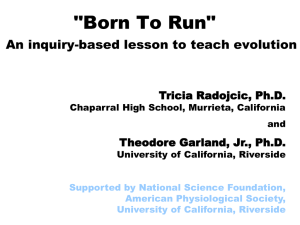

![Historical_politcal_background_(intro)[1]](http://s2.studylib.net/store/data/005222460_1-479b8dcb7799e13bea2e28f4fa4bf82a-300x300.png)
